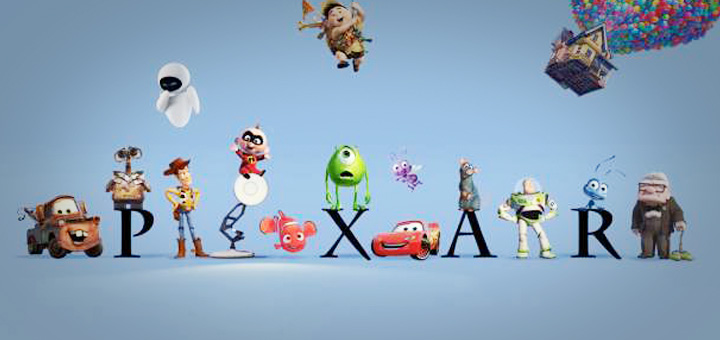Here are Pixar’s 22 Rules of Storytelling, written by Emma Coats, one of Pixar’s story artists. This is great stuff, but perhaps not as relevant for developing stories in business presentations as it is for people working in motion pictures.
Using Coats’ original tips as a springboard, I’ve added a few thoughts of my own to adapt her advice to define – or refine – your storytelling for maximum impact.

1. You admire a character for trying more than for their successes.
Give some thought to who you choose as your story’s lead character. People learn better from those who make mistakes, not from perfectionists who never learn anything.
2. You must keep in mind what’s interesting to you as an audience, not what’s fun to do as a writer. They can be very different.
Don’t use storytelling that only appeal to you as the speaker. Your audience is always more important than you.
3. Trying for theme is important, but you won’t see what the story is actually about until you’re at the end of it. Now rewrite.
As you develop your story, it’s easy for it to veer away from its purpose. Remember that the point of the story – which comes at the end – must connect back to the reason why you’re telling the story in the first place. A story without a purpose confuses the audience.
4. Once upon a time there was ___. Every day, ___. One day ___. Because of that, ___. Because of that, ___. Until finally ___.
Introduce your lead character in a situation that’s not ideal, or at least not ideal to them. Then, add something that challenges what the character believes or expects. Sometimes that challenge comes from another person. That challenge needs to force a learning or a change, perhaps for the better, but not always. The quality of the story is directly linked to the urgency of the change, or the challenge to the person’s morals, or both.
As an example, this is not a story: “Last night, I went home to do laundry. I put all of it in the washer, and when it was finished, the clothes came out clean!”
5. Simplify. Focus. Combine characters. Hop over detours. You’ll feel like you’re losing valuable stuff, but it sets you free.
The best business stories are short and concise. They get the point across with minimal detail. Less detail also encourages more imagination.
6. What is your character good at, comfortable with? Throw the polar opposite at them. Challenge them. How do they deal?
Drama makes the story. Even comedic stories need a character in drama.
7. Come up with your ending before you figure out your middle. Seriously. Endings are hard, get yours working up front.
A good story is sort of like a circle. The ending must return to the beginning. The conclusion supports the story’s purpose. If they don’t sync, the audience will get confused.
8. Finish your story, let go even if it’s not perfect. In an ideal world you have both, but move on. Do better next time.
Alas, sometimes your stories won’t work. Like everything in life, learn from it and move on. Or road-test your story aloud in front of someone’s who constructive and specific.
9. When you’re stuck, make a list of what wouldn’t happen next. Lots of times the material to get you unstuck will show up.
A classic way to brainstorm. Do the opposite, then force-fit the responses to a new ending.
10. Pull apart the stories you like. What you like in them is a part of you. You’ve got to recognize it before you can use it.
The best way to learn how something works is to rip it apart, understand each part, then put it back together again. Look for stories you like, and ask yourself: what made the story work?
11. Putting it on paper lets you start fixing it. If it stays in your head, a perfect idea, you’ll never share it with anyone.
I say this in every class I teach! Get your ideas out of your head! They’re useless in your head. Write it down! Write it down!
12. Discount the first thing that comes to mind. And the 2nd, 3rd, 4th, 5th – get the obvious out of the way. Surprise yourself.
Another truth of brainstorming. Your first ideas are just brain farts. Get them out of the way and drill down until you find the new.
13. Give your characters opinions. Passive/malleable might seem likable to you as you write, but it’s poison to the audience.
Strong opinions stretch imaginations. They cause your audience to talk to each other, or re-tell it to others to get their reaction. That’s a huge win right there.
14. Why must you tell THIS story? What’s the belief burning within you that your story feeds off of? That’s the heart of it.
So true. Every story must have a simple, essential truth.
If you were your character, in this situation, how would you feel? Honesty lends credibility to unbelievable situations.
Honesty and credibility is just another way of saying you need to have authenticity as a storyteller. Some part of the story must reinforce part of your own DNA. In other words, a good story – even if it’s not about you – says something about you.
16. What are the stakes? Give us reason to root for the character. What happens if they don’t succeed? Stack the odds against.
Yes, but if the lead character fails, what did they learn? A good story in business encourages learning if not reflection.
17. No work is ever wasted. If it’s not working, let go and move on – it’ll come back around to be useful later.
I have about 20 stories in my head that aren’t ready yet. They’re missing something. That’s OK, like any type of challenging work, put it aside, do something else, and come back to it later.
18. You have to know yourself: the difference between doing your best and fussing. Story is testing, not refining.
Even if the story isn’t about you, stories come from you and illuminate you. They are one of the most effective ways to humanise yourself. Good stories are also transferable. Someone can repeat your story to someone else, so they live on beyond the original situation.
19. Coincidences to get characters into trouble are great; coincidences to get them out of it are cheating.
Give your audience realistic hope.
20. Exercise: take the building blocks of a movie you dislike. How can you rearrange them into what you DO like?
Listen to others’ stories at work. What makes them relevant? What made them memorable? Was it the character? The situation? The problem or challenge? What you like says something about you too.
21. You gotta identify with your situation/characters, can’t just write ‘cool’. What would make YOU act that way?
Make your lead character believable and relevant. Audiences don’t connect to someone they can’t relate.
22. What’s the essence of your story? Most economical telling of it? If you know that, you can build out from there.
Oftentimes, I find a story I like but it doesn’t work in context. One reason it usually isn’t working it because I don’t have or know the need or objective. Once you know WHY you need a story and WHAT it must say, it’s not only easier to define the story, it’s also easier to tell.
For a different (but similar) point-of-view, try this article from Forbes magazine: The Power Of Storytelling For Your Business: Unleashing Your Inner Storyteller.
Any other lessons you’ve used or learnt in terms of coming up with the right story? Please add your comments below.


No comment yet, add your voice below!